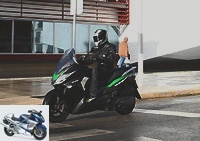Kawasaki J300 scooter first test

Both practical and efficient, the first Kawasaki scooter imported into Europe is a success thanks to its genes and its sporty lines, in line with the motorcycles of the Akashi brand. First try.
A 300 cc nerf ball
A priori, as the French tend to demonstrate, scooters with displacements of between 125 cc and 500/600 cc attract the French only moderately …
Logical after all, insofar as the 125 cc are accessible to car licenses while a model like this J300 requires a motorcycle license. Result: this type of "in-between" appear moderately attractive, especially as their volumes and their weight (191 kg all full made for the J300) are sometimes barely lower than certain maxi-scooters (randomly: 217 kg all full made for the Tmax 530) !
But on closer inspection, this J300 has many advantages for those who wish to go beyond the 125 cc, often considered too sluggish during peri-urban trips, but who cannot – or do not want – to turn to a "big" 500/600 cc. First in-between: the price! Because in maxi scooters, the bar often reaches the 10,000 euros mark – or even happily exceeds it for the more "premium" ones. !
Under these conditions, the 5,099 euros requested for the Kawasaki scooter put it within reach of more purses, in particular those weakened by the economic crisis … A potentially "profitable" strategy commercially !
In addition, if 300 cc may appear a little "fair" on paper, this displacement is on the contrary very satisfactory in use. Despite its "small" 28 hp, the J300 is rather nervous at start-up and will not "green" because of this aspect in the face of larger engines..
With less than 200 kg advertised, it is easy to maneuver when stationary and easy to mount on its central stand, even for users (and users) who lack strength.
In terms of ergonomics, the pilot has only a small enough space to place his legs, resulting in a fairly folded position. An unfortunate detail for those who preferred to drive with their legs extended…
However, except at the level of the legs, even a rider exceeding 1.80m does not really feel cramped: we can thus benefit from the excellent turning radius, without having the handlebars hitting the knees..
Culminating at a respectable height of 775 mm, the saddle offers a breathtaking view of the dashboard. The opportunity to familiarize yourself with modern instrumentation, composed of a digital screen interposed between two analog dials. The assembly provides information on speed (in km / h or miles), engine speed, total mileage, time, fuel level and engine temperature.
Finally, the resetting of the two partial trips is controlled by a cursor located below the LCD screen. Ready? On the way !
Related articles
-
All Tests – First test of the Kawasaki J300 scooter – A judicious alliance
Kawasaki J300 scooter first test Both practical and efficient, the first Kawasaki scooter imported into Europe is a success thanks to its genes and its…
-
All Tests – First test of the Kawasaki J300 scooter – Nervous and comfortable
Kawasaki J300 scooter first test Both practical and efficient, the first Kawasaki scooter imported into Europe is a success thanks to its genes and its…
-
All Tests – Kawasaki J300 scooter first test – Kawasaki J300 technical sheet
Kawasaki J300 scooter first test Both practical and efficient, the first Kawasaki scooter imported into Europe is a success thanks to its genes and its…
-
Peugeot Vivacity 125 first test: a very urban scooter ! The range of Peugeot 125 scooters is expanding with the 125 cc version of the renowned Vivacity:…
-
Honda PCX first test: the low cost scooter with fanfare ! It was in Barcelona that Site was able to discover the new entry-level Honda 125 scooter, the…
-
J125 test: the small Kawasaki scooter for the general public After having entered the niche of mid-displacement scooters with the J300, Kawasaki is…
-
All Tests – Kawasaki W800 Test Drive: Back to the Past! – Luxury, calm and voluptuousness
Kawasaki W800 test: back to the past ! Like the Z, the W is a separate letter in the Kawasaki alphabet … In 2011, the new Kawasaki W800 revives the…
-
Peugeot Vivacity 125 first test: a very urban scooter ! The range of Peugeot 125 scooters is expanding with the 125 cc version of the renowned Vivacity:…
-
Peugeot Vivacity 125 first test: a very urban scooter ! The range of Peugeot 125 scooters is expanding with the 125 cc version of the renowned Vivacity:…
-
Quadro4 4-wheel scooter test: the Quadroture du cercle Long awaited, the world’s first 4-wheel scooter is finally on the market. MNC gives you its first…